The Oregon missionaries were pioneers who settled in the Oregon Country of North America starting in the 1830s dedicated to bringing Christianity to local Native Americans. There had been missionary efforts prior to this, such as those sponsored by the Northwest Company with missionaries from the Church of England starting in 1819. The Foreign Mission movement was already 15 years underway by 1820, but it was difficult to find missionaries willing to go to Oregon, as many wanted to go to the east, to India or China. It was not until the 1830s, when a schoolmaster from Connecticut, Hall Jackson Kelley, created his "American Society for the Settlement of the Oregon Country," that more interest and support for Oregon missionaries grew. Around the same time, four Nez Perce arrived in St. Louis in the fall of 1831, with accounts differencing as to if these travelers were asking for “the book of life,” an idea used by Protestant missionaries, or if they asked for “Blackrobes,” meaning Jesuits, thus Catholic missionaries. Either way this inspired Christian missionaries to travel to the Oregon Territory. Oregon missionaries played a political role, as well as a religious one, as their missions established US political power in an area in which the Hudson’s Bay Company, operating under the British government, maintained a political interest in the Oregon country. Such missionaries had an influential impact on the early settlement of the region, establishing institutions that became the foundation of United States settlement of the Pacific Northwest.
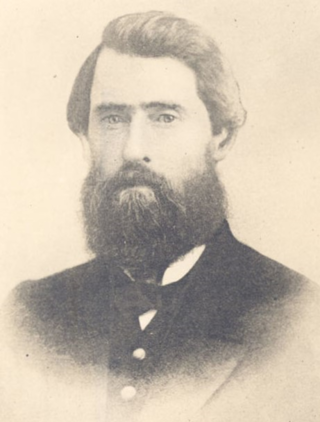
Jason Lee was a Canadian Methodist Episcopalian missionary and pioneer in the Pacific Northwest. He was born on a farm near Stanstead, Quebec.

Willamette Heritage Center is a museum in Salem, Oregon. The five-acre site features several structures listed on the National Register of Historic Places including the Thomas Kay woolen mill, the Jason Lee House, Methodist Parsonage, John D. Boon House, the Pleasant Grove (Condit) Church. The houses and church were relocated to the mill site. The Center also includes a research library and archives of Marion County history.

The Champoeg Meetings were the first attempts at formal governance by European-American and French Canadian pioneers in the Oregon Country on the Pacific Northwest coast of North America. Between 1841 and 1843, a series of public councils was held at Champoeg, a settlement on the French Prairie of the Willamette River valley in present-day Marion County, Oregon, and at surrounding settlements. The meetings were organized by newly arrived settlers as well as Protestant missionaries from the Methodist Mission and Catholic Jesuit priests from Canada.
Alanson Beers was an American pioneer and politician in the early days of the settlement of the Oregon Country. A blacksmith by trade, he was a reinforcement for the Methodist Mission in what would become the state of Oregon. The Connecticut native helped found the Oregon Institute and participated in the Champoeg Meetings where he was elected to serve on the Executive Committee in 1843.

Doctor Ira Leonard Babcock was an American pioneer and doctor in the Oregon Country. A native of New York, he was selected as the first Supreme Judge with probate powers in February 1841 in what would become the state of Oregon.
The Methodist Mission was the Methodist Episcopal Church's 19th-century conversion efforts in the Pacific Northwest. Local Indigenous cultures were introduced to western culture and Christianity. Superintendent Jason Lee was the principal leader for almost a decade. It was a political and religious effort. Two years after the mission began, the church's Board of Foreign Missions described its intent to reclaim "these wandering savages, who are in a very degraded state, to the blessings of Christianity and civilized life." Alongside the missions founded in the region were several secular operations opened. These were maintained to allow for material independence from the Hudson's Bay Company (HBC), then the preeminent economic entity in the region among European descendants.
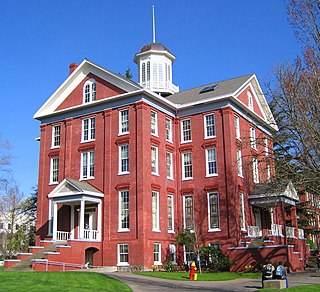
Waller Hall is a building on the campus of Willamette University in Salem, Oregon, in the United States. Opened in 1867 as University Hall, it is the oldest higher-education building west of the Mississippi River still in use, currently housing the university's administrative offices.
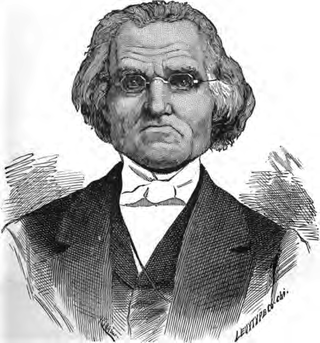
David Leslie was an American missionary and pioneer in what became the state of Oregon. A native of New Hampshire, he joined Jason Lee as a missionary at the Methodist Mission in the Oregon Country in 1836. In that region he participated in the early movement to start a government and his home was used for some of these meetings. With the closing of the mission he became a founder of the city of Salem, Oregon, and board member of the Oregon Institute, which later became Willamette University.
Webley John Hauxhurst Jr. was a pioneer in Oregon Country. He helped build the first grist mill in Oregon, participated in the Willamette Cattle Company, and was a participant at the Champoeg meeting where he voted for the creation of a provisional government.
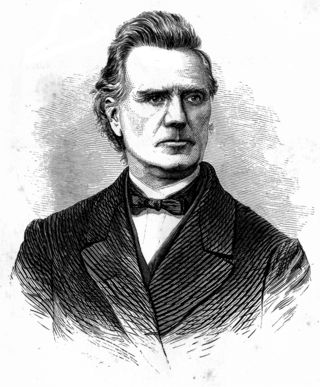
Reverend Gustavus Hines was an American missionary in Oregon Country. Working for the Methodist Mission in what became the state of Oregon, the New York native became involved in early attempts to form a government at the Champoeg Meetings in 1841. Later he served on the board of trustees for the Oregon Institute, which became Willamette University, and wrote several books on Oregon.
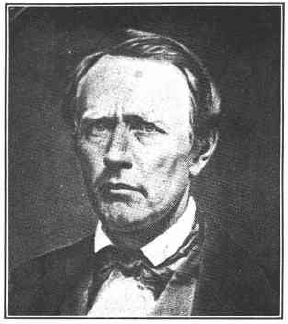
William Holden Willson was a pioneer of the U.S. state of Oregon and the founder of its capital city, Salem. A native of New Hampshire, he immigrated to the Oregon Country in 1837 to work at the Methodist Mission, and there would participate in the Champoeg Meetings. Willson served as the first treasurer of the Provisional Government of Oregon.

Reverend Josiah Lamberson Parrish was an American missionary in the Pacific Northwest and trustee of the Oregon Institute at its founding. A native of New York, he also participated in the Champoeg Meetings that led to the formation of the Provisional Government of Oregon in 1843. Parrish was married three times and was the first breeder of pure-bred sheep in Oregon.

Alvin F. Waller (1808–1872) was an American missionary in Oregon Country and an early leader at Willamette University in Salem, Oregon. He was a native of Pennsylvania and helped found the first Protestant church west of the Rocky Mountains in 1843 in Oregon City.
Dr. Elijah White (1806–1879) was a missionary and agent for the United States government in Oregon Country during the mid-19th century. A trained physician from New York State, he first traveled to Oregon as part of the Methodist Mission in the Willamette Valley. He returned to the region after a falling-out with mission leader Jason Lee as the leader of one of the first large wagon trains across the Oregon Trail and as a sub-Indian agent of the federal government. In Oregon he used his authority to regulate affairs between the Natives and settlers, and even between settlers. White left the region in 1845 as a messenger for the Provisional Government of Oregon to the United States Congress, returning in 1850 before leaving again for California in the early 1860s.
Philip Leget Edwards was an American educator from the state of Kentucky and first teacher in what became the state of Oregon. After teaching in Missouri, he traveled to the Oregon Country with Jason Lee and helped establish the Methodist Mission. He was also involved with the Willamette Cattle Company before returning to Missouri where he became a lawyer and was on officer in the militia fighting against the Mormons. After moving to California, he served in the state assembly.

Lausanne Hall is a college residence hall at Willamette University in Salem, Oregon, United States. Built in 1920, the red-brick and stone-accented structure stands three stories tall along Winter Street on the western edge of the campus that was originally a residence for women only. The late Gothic Revival style building replaced a home that had also been used as a dormitory. This structure was moved to campus and originally was named as the Women's College before assuming the name of Lausanne.

Chloe Aurelia Clark Willson (1818–1874) was an early pioneer of what became the U.S. state of Oregon, and one of the first teachers of the Methodist mission in the Willamette Valley. In 1850, she owned half of the land in Oregon's state capital Salem.
The Clatsop Mission was an outpost of the Methodist Mission near modern Astoria, Oregon, United States. Joseph H. Frost and his family was sent to the Clatsop Plains at the mouth of the Columbia River in 1841. Frustrated at his inability to convert the local Clatsop and Nehalem people, Frost took his family and left the area in August 1843. Josiah Parrish was appointed as his replacement, working at the station until its closure the following year in 1844.

Thomas Dove Keizur was one of the earliest American pioneers to settle in the Oregon Country. In 1843, he led his large family from Missouri to Oregon over the Oregon Trail. He homesteaded in Oregon's Willamette Valley in an area north of modern-day Salem, Oregon. Keizur was one of eight citizens elected to serve on Oregon's third pre-provisional legislative committee which helped lay the foundation for the establishment of the Oregon Territory. He was also the first captain of the Oregon Rangers, the first militia unit organized in Oregon. Today, the city of Keizer, Oregon, is named in his honor.













